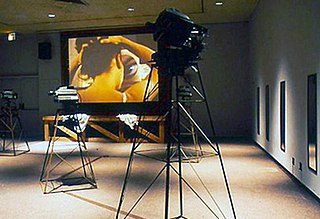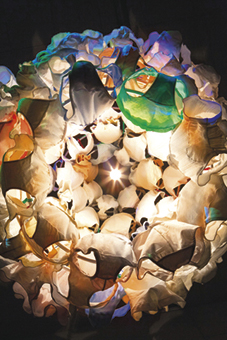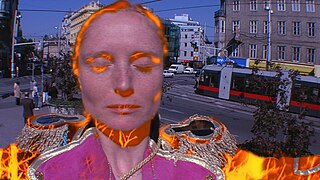
I'm Not The Girl Who Misses Much is a 1986 multimedia installation art piece by Swiss artist Pipilotti Rist. It includes distorted images and sound of the artist performing Happiness Is a Warm Gun (originally by The Beatles).

I'm Not The Girl Who Misses Much is a 1986 multimedia installation art piece by Swiss artist Pipilotti Rist. It includes distorted images and sound of the artist performing Happiness Is a Warm Gun (originally by The Beatles).
I′m Not The Girl Who Misses Much is a single-channel video and is the artist's first video work while she was a student at Schule für Gestaltung Basel in the Audiovisual Communication program. [1] Rist developed the video single-handedly in her studio, a creation process she later used with her piece, Selbstlos im Lavabad (1994). [2] The video has a total length of 5 minutes.
In this video, Pipilotti Rist appears in the role of a singer. Her breasts deliberately spill out of her black dress while she jerks her body across the screen in front of a red background. [3] The protagonist repeatedly sings parts of the song Happiness Is a Warm Gun , which was created in 1968 by John Lennon and Paul McCartney for their White Album and dedicated by John Lennon to his partner Yoko Ono. [4] Rist changed the verse She′s not the girl who misses much to I'm not the girl who misses much. In this way, the artist does not leave the description of herself as a person to other people but defines herself in a powerful and self-determined way. [4]
Image and sound are distorted in various ways: The image is blurred, white lines of an electronic sound signal constantly move from top to bottom over Rist's body or through it in the first part of the video. [5] Later, the image distortion occurs through jagged vertical lines which lead the left part of the image to a standstill. It shifts further and further to the right until it finally stops, while the sound continues. This occurs in a loop. In this phase, the background is no longer red, but beige. The sound in general is distorted by a fast forward effect, which as a result generates a cartoonish voice. Later, the sound is muffled by slow motion rendering the lyrics barely understandable.
At the very end, Lennon can be heard singing part of the song but with the original lyrics, She′s not the girl who misses much. You can still see the singer but now located in front of a blue background.

Visual artist Joan Jonas acknowledges a parallel to the first depictions of hysterical women by Jean-Martin Charcot in Paris in the 19th century, in which women acted out seizures for the camera. [5] However, by switching from the third to the first person in the first song line, the artist redefines the relationship between subject and object. In her later work, this became a recurring theme. By breaking with the demotion of the female body in media depictions of the time, she appropriates the narrative and makes it her own. In a way, the audience is encouraged to pay attention to their own bodies. [3]
In this early work, Rist presents us with the voyeuristic camera view on the female body according to Elisabeth Bronfen, but at the same time destroys its effect in three ways: dance movements and voice appear distorted, the body is darkened by a color filter and blurred throughout the work. Although the breasts are visible, there is no erotic pleasure. In the few bars of the song that can be heard at normal speed in the end, John Lennon′s voice acts as a counterpoint to the female vocals. [6]
The distortions created in post-production prevent the body from becoming an object for the spectators. It can be seen as a tool to avoid the fetishization of the female body. By this she joins the ranks of other female media artists and filmmakers such as Nan Hoover, who used close-ups of body parts as a means of de-objectification and desexualization in works such as Landscape (1983). Rist developed this approach further in later works such as Pickelporno (1992). [4]
The question has often occurred whether Rist was delivering a personal statement through her artwork or whether the depiction can also be generalized and its meaning transferred to other women of her generation, which would put it in a social-political context. Laura Leuzzi tends towards the second option. She reads the work as deliberately undermining common beauty ideals through the means of distortion and alienation effects to reference social and gender norms. [4]

Rist takes her cues from the duration and playful erotic soundtrack of advertising clips and music videos of the time. However, she clearly distinguishes the work from these genres by sometimes reducing the speed of the image, sometimes speeding it up, and repeating the song line several times. [3] In addition, the image is disturbed by the lines that distort the image.
In an interview with Jane Harris, Rist described her bodily movements in this work as an "exorcism dance". The movements in the video seem to break the boundaries of the screen and the motion of her arms and legs are reminiscent of dolls – which can be read as a reference to the audience to reflect upon whether they are still in control of their lives or whether their identity is already represented and interpreted by television images. [7] The video has often been interpreted as a commentary on the remote-controlled human being, [8] but the line-distorted presentation also draws attention to the monitor and the inadequacies of video technology. [3]
The performance at some point seems to become in sync with the electronic impulses, the protagonist seems breathless and hysterical. Image and sound, video, and electronics create a harmonical flow. Here, as in later works, Rist′s frequent use of surveillance cameras and constant close-ups create a shift in perspective: the medium becomes the content. [5]
Rist published the installation as an edited video in a “luxury box” in a limited edition of 300 copies as a VHS cassette. [1]
Video art is an art form which relies on using video technology as a visual and audio medium. Video art emerged during the late 1960s as new consumer video technology such as video tape recorders became available outside corporate broadcasting. Video art can take many forms: recordings that are broadcast; installations viewed in galleries or museums; works either streamed online, or distributed as video tapes, or on DVDs; and performances which may incorporate one or more television sets, video monitors, and projections, displaying live or recorded images and sounds.

Yoko Ono is a Japanese multimedia artist, singer, songwriter, and peace activist. Her work also encompasses performance art and filmmaking.
Jennifer Anne Saville is a contemporary British painter and an original member of the Young British Artists.

Shigeko Kubota was a Japanese video artist, sculptor and avant-garde performance artist, who mostly lived in New York City. She was one of the first artists to adopt the portable video camera Sony Portapak in 1970, likening it to a "new paintbrush." Kubota is known for constructing sculptural installations with a strong DIY aesthetic, which include sculptures with embedded monitors playing her original videos. She was a key member and influence on Fluxus, the international group of avant-garde artists centered on George Maciunas, having been involved with the group since witnessing John Cage perform in Tokyo in 1962 and subsequently moving to New York in 1964. She was closely associated with George Brecht, Jackson Mac Low, John Cage, Joe Jones, Nam June Paik, and Ay-O, among other members of Fluxus. Kubota was deemed "Vice Chairman" of the Fluxus Organization by Maciunas.

Pipilotti Elisabeth Rist is a Swiss visual artist best known for creating experimental video art and installation art. Her work is often described as surreal, intimate, abstract art, having a preoccupation with the female body. Her artwork is often categorized as feminist art.

"Edge of Seventeen" is a song by the American singer-songwriter Stevie Nicks from her debut solo studio album Bella Donna (1981), released as the third single from the album on February 4, 1982. The lyrics were written by Nicks to express the grief resulting from the death of her uncle Jonathan and the murder of John Lennon during the same week of December 1980. The song features a distinctive, chugging 16th-note guitar riff, drum beat and a simple chord structure typical of Nicks' songs. The song's title for the single release was "Edge of Seventeen (Just Like the White Winged Dove)". In the United States, "Edge of Seventeen" just missed out on the top 10 of the Billboard Hot 100, peaking at No. 11. Despite this, it became one of Nicks' most enduring and recognizable songs and has been covered by several artists. In 2021, it was ranked No. 217 on Rolling Stone's list of the "500 Greatest Songs of All Time".

Lynda Benglis is an American sculptor and visual artist known especially for her wax paintings and poured latex sculptures. She maintains residences in New York City, Santa Fe, New Mexico, Kastellorizo, Greece, and Ahmedabad, India.

A video sculpture is a type of video installation that integrates video into an object, environment, site or performance. The nature of video sculpture is that it utilizes the material of video in an innovative way in space and time, different from the standard traditional narrative screening where the video has a beginning and end.

Amethyst Amelia Kelly, known professionally as Iggy Azalea, is an Australian rapper, songwriter, model and businesswoman. Born in Sydney, Australia, Azalea moved to the United States at the age of 16 in order to pursue a career in music. Azalea earned public recognition after releasing the music videos for her songs "Pussy" and "Two Times" on YouTube. Shortly after releasing those two songs, she released her debut mixtape, Ignorant Art (2011), and subsequently signed a recording contract with American rapper T.I.'s Grand Hustle label.

"Bad Girls" is a song by British recording artist M.I.A. from her fourth studio album Matangi (2013). It was released by Interscope Records on 31 January 2012 as the lead single from the album. The song was written by M.I.A., Marcella Araica and Danja, and produced by the latter. It was her first release with Interscope following her departure from XL Recordings in 2011. A shorter version of the song appeared on M.I.A.'s mixtape Vicki Leekx (2010).
The feminist art movement refers to the efforts and accomplishments of feminists internationally to produce art that reflects women's lives and experiences, as well as to change the foundation for the production and perception of contemporary art. It also seeks to bring more visibility to women within art history and art practice. The movement challenges the traditional hierarchy of arts over crafts, which views hard sculpture and painting as superior to the narrowly perceived 'women's work' of arts and crafts such as weaving, sewing, quilting and ceramics. Women artists have overturned the traditional view by, for example, using unconventional materials in soft sculptures, new techniques such as stuffing, hanging and draping, and for new purposes such as telling stories of their own life experiences. The objectives of the feminist art movement are thus to deconstruct the traditional hierarchies, represent women more fairly and to give more meaning to art. It helps construct a role for those who wish to challenge the mainstream narrative of the art world. Corresponding with general developments within feminism, and often including such self-organizing tactics as the consciousness-raising group, the movement began in the 1960s and flourished throughout the 1970s as an outgrowth of the so-called second wave of feminism. It has been called "the most influential international movement of any during the postwar period."

Dorit Cypis is a Canadian-American artist, mediator and educator based in Los Angeles. Her work has collectively explored themes of identity, history and social relations through installation art, photography, performance and social practice. After graduating from California Institute for the Arts (CalArts), she attracted attention in the 1980s and 1990s for her investigations of the female body, presented in immersive installation-performances at the Whitney Museum, International Center of Photography, San Francisco Museum of Modern Art (SFMOMA), and Musée d'art contemporain de Montréal. Counter to much feminist work of the time, Cypis focused on interiority and personal mythologies rather than exterior political realms, and according to art historian Elizabeth Armstrong, made a significant contribution to discourse about the representation of women and female sexuality.
Kalliope Amorphous is an American interdisciplinary artist who works in a variety of media, including photography, poetry, performance art, and olfactory art. She is primarily known for her conceptual self portraits. She lives and works in New York City.

Annelies Štrba is a Swiss multimedia artist, who lives in the Zurich metropolitan area. She works with video, photography, and digital media to approach her subjects, which range from domestically themed images, portraiture, and both urban and natural landscapes.
Kapwani Kiwanga is a Canadian artist working in Paris, France. Her work is known for dealing with issues of colonialism, gender, and the African diaspora.

Ever Is Over All is an audiovisual installation by Swiss artist Pipilotti Rist created in 1997.

TV-Lüster (1993) is a 6-channel video installation by Swiss multimedia artist Pipilotti Rist from 1993. It has been on permanent display in the hall of the Kunstmuseum St. Gallen since 1994.

Pepperminta is the first feature film written and directed by Swiss video artist Pipilotti Rist from 2009. Filmed in Vienna and St. Gallen, the experimental film is commonly read as a modern fairy tale. It depicts a group of friends who embark on a journey to save the world through color. It premiered on September 5, 2009, at the 66th Venice International Film Festival in the Horizons (Orizzonti) section.

Homo Sapiens Sapiens is an audiovisual installation by the Swiss artist Pipilotti Rist created in 2005.
Pixelwald, english title Pixel Forest, is an audio-video installation by Swiss artist Pipilotti Rist from 2016.